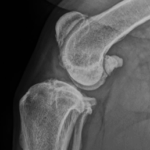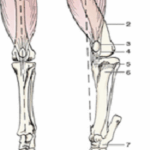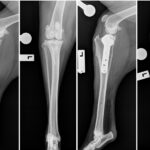Congenital heart disease – aortic stenosis
Aortic stenosis is one of the more common congenital heart defects in dogs. The condition is often discovered in apparently healthy dogs by a vet during a routine examination (such as before vaccination).
If your vet identifies a heart murmur in your puppy it is essential to have further investigation to establish the cause of the murmur so that appropriate treatment can be given early.
What causes aortic stenosis?
Aortic stenosis is a congenital heart defect. Interestingly, the lesion tends to develop within the first 3 months of life after the puppy is born, as opposed to being present at the time of birth. Aortic stenosis occurs when a constricting ring or ridge of tissue develops directly below the aortic valve, causing an obstruction to blood flow out of the heart. This means that insufficient blood flow may occur, particularly during exercise or times of stress. It is more commonly seen in certain breeds of dog (Golden Retriever, Boxer, German Shepherd Dog, Newfoundland, Rottweiler).
Since the heart has to work harder to pump blood through a narrowed exit the muscles of the heart get larger (hypertrophy). The hypertrophied heart muscles can become deprived of normal blood flow and oxygen, and this can result in abnormal heart beats and dysrhythmias. This may further reduce the ability of the heart to provide the body with an adequate blood supply. Fainting is caused by an insufficient blood supply to the brain.
How would I know if my dog has aortic stenosis?
Although the condition is present shortly after birth, signs may not be noticed until later in life. Many dogs with aortic stenosis have no outward signs of illness. More severely affected animals may be reluctant to exercise, or may faint without warning (especially when excited or exercising). If the condition is left untreated animals may develop heart failure and signs of breathlessness or coughing may occur. Sudden death may occur in young dogs (less than 4 years of age) with marked to severe disease.
How will my vet know what is wrong with my dog?
If your vet hears a murmur when listening to your dogs heart they will want to do some other tests. Heart murmurs are caused by the sound of abnormal and high-speed blood flow and are very common findings in dogs with subaortic stenosis. Very quiet heart murmurs can be present in an otherwise healthy pet so a diagnosis of subaortic stenosis or other congenital heart disease is not necessarily inevitable.
Ultrasound is the method of choice for finding the cause of a heart murmur. If a heart murmur is heard, an ultrasound examination is recommended. Ultrasound examination of the heart requires considerable knowledge and experience and should be performed by someone with experience in examining young dogs.
X-rays are important in the diagnosis and monitoring of heart disease but will not identify the cause of a heart murmur. X-rays are used to see if signs of heart failure are present, if there any signs of further heart damage treatment should be started immediately.
Will my dog get better?
If the aortic stenosis is mild your dog could lead a normal life without treatment. However, in severe cases the outlook is poor. Dogs with significant signs of disease, eg collapse or breathlessness at an early age are likely to require lifelong medication and have a significantly reduced lifespan. Your vet will discuss the outlook and long term management of your dog with you.
Can aortic stenosis be treated?
In mild cases, it is not necessary to treat aortic stenosis and affected animals will often live a normal life. If disease is severe or if clinical signs are apparent then treatment will usually be prescribed. Your veterinarian may prescribe drugs to reduce heart rate and minimize abnormal heart rhythms. If heart failure is present, your vet may suggest drugs such as diuretics, or ACE inhibitors to reduce fluid build up. You may be advised to restrict your dogs exercise.
Surgical procedures are available and some dogs may be suitable for a balloon valvuloplasty (when a catheter with a balloon tip is inserted into the obstructed blood vessel and the balloon inflated to open the artery). These procedures may improve or resolve clinical signs in some dogs but are not without risk.
How long will my dog live?
Many animals with mild aortic stenosis live a normal life with no signs of heart disease. Severely affected animals are at risk of sudden death or development of heart failure and quality of life may be reduced in these animals. Approximtely 75% of dogs with severe disease will die suddenly from abnormal heart rhythms before the age of three. All dogs with subaortic stenosis are at risk for development of infections on the heart valves (infectious endocarditis), and prophylactic antibiotics should be routinely administered during surgical or dental procedures, or with any other condition that may predispose dogs to infection.
Affected dogs and their parents (who could be genetic carriers of the condition) should be not be allowed to breed.
Source of information: www.vetstream.com



